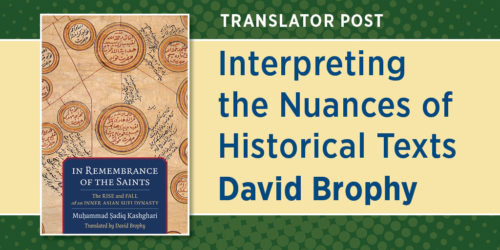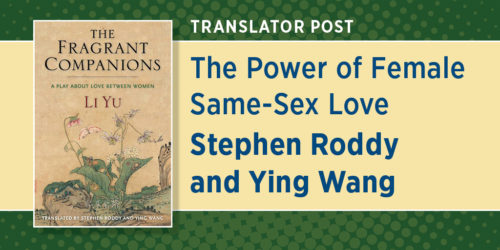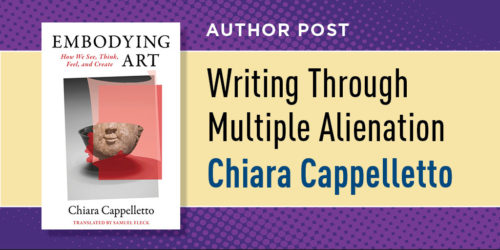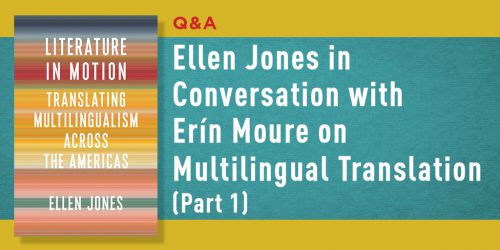Ellen Jones in Conversation with Erín Moure on Multilingual Translation (Part 2)

Continuing the conversation with Literature in Motion author Ellen Jones and poet-translator Erín Moure, today’s installment explores the permeability of language. Interested in the fluid and the multilingual, Moure invites readers to join her in the joy of engaging with writing that inhabits the seams of cultures, dialects, and readability. Moure declares, “I’m not afraid of difficulty.” Are you?
Ellen Jones: Mar Paraguayo engages with fluidity of many kinds (it’s there in the title!)––linguistic and textual and conceptual. How do you understand the relationship between its language and its representation of fluid desires and gender identifications?
Erín Moure: I feel it in my being. As a lesbian and allergiqueer writer who lives in and among many people who are in many ways fluid in their expressions of gender and desire, and in the way they view the world (all worldviews are propelled into possibility via desire and its permutability of body and site), the ways they write of the world, share place, and inhabit it and rebel against its strictures and oppressions, its historical divisions, the book’s multiply readable presentations of gender were welcome to me. From the start, all the possibilities reverberated for me.
EJ: Hearing you read aloud from the opening of Paraguayan Sea, I was struck by how different a sonic life you gave it, compared to how the book sounds in my head. This is in part due to your reliance on vocabulary that’s shared between English and French: words like suicide, cascade, etc. How did you come to establish this translation strategy and what does it allow you to do as a translator?
EM: I’m often told that when I read my own poems aloud, it alters the hearer’s ability to hear and sound the poems. In reading a text aloud, you have to deal with the muscles and apparatus of the mouth, and different muscles are used when speaking different languages. In reading Paraguayan Sea aloud, I end up speaking English words with a French accent and French words with an English one; it’s impossible to stabilize the reading, really, so I just let it work itself out. The translation strategy was to write in Frenglish, taking advantage of French words that are similar to English words to ensure that U.S. Americans could still enter into and read the book, even if their French was extremely limited . . . I tried to enter into the American head and ears to create the work. I often mix languages in my own poetic work, and this was a unique chance to do it in a translation, just responding to the mixed text and creating similar rhythmic values, a flow, and not worrying whether French or English came out of me (while putting the brakes on French at times!).
EJ: You often choose to translate texts that are understood as “difficult.” Much of your work challenges standards of accessibility, demanding close engagement and sometimes partial confusion. How do you walk the fine line between difficulty and readability here and in your other work?
EM: It’s an open question every time. I’m not afraid of difficulty; I flourish in it. I love listening to language. I have confidence in my readers to do the same, while understanding that not every literary text is for every reader. I want readers to feel the exhilaration I feel in reading the original book: it’s that desire for sharing the amazement that leads me to translate. I never find I am walking a fine line between difficulty and readability . . . it’s more like walking on a broad dike that’s sinking and crumbling but still walkable, with views on both sides and amazing smells and animals and birds, though who knows if the dike will still be intact after the next runoff or rain
EJ: Paraguayan Sea is by no means your only multilingual project. You are constantly working across languages––French, Spanish, Portuguese, Galician, most recently Ukrainian––in all your literary projects. Could you tell us a little about what you’re working on at the moment? I’m especially keen to hear about your translations of poems by Andrés Ajens.
EM: Andrés Ajens is another amazing poet, whose dense linguistic play and literary echoes, and deep take on colonialism in South America, are powerful, challenging. I’ve been translating bits of his work since 1998, asking him a million questions each time, as I am North American and blind to a Southern American view. I am still seeking a publisher for what I have assembled.
In fall 2021, my translation of Chus Pato’s Un libre favor as The Face of the Quartzes came out from Veliz Books, and I’ve been working on poetry-reading videos to spread the news about that book, and celebrating the new attention to Chantal Neveu’s This Radiant Life (recently awarded the 2021 Governor General’s Literary Award for Translation from French into English), a book that also has some English in it in the original (La vie radieuse), so the polylinguistic challenge was present there too. I’m working on a new book of my own, Theophylline, which does involve thinking about translation but on another level as I’m speaking about three writers who wrote in American English and about receiving them as someone who is foreign to their time and place. Those are the main projects; there are others! Fortunately, I live in a lively mixophone community, presential and virtual, of readers, writers, artists, thinkers, curators, friends: they give me energy!
Ellen Jones is a literary translator and an editor. Her translations from Spanish include Ave Barrera’s The Forgery (co-translated with Robin Myers, 2022), Bruno Lloret’s Nancy (2020), and Rodrigo Fuentes’s Trout, Belly Up (2019). She is the author of Literature in Motion: Translating Multilingualism Across the Americas, which will be available in January 2022.
Erín Moure’s most recent poetry collection is The Elements (House of Anansi Press, 2019), “a book of Dad.” The Face of the Quartzes, from Veliz Books (2021), is her sixth translation from the work of Galician poet Chus Pato. A forty-year retrospective, Planetary Noise: Selected Poetry of Erín Moure, appeared in 2017 from Wesleyan University. More info at erinmoure.mystrikingly.com.








